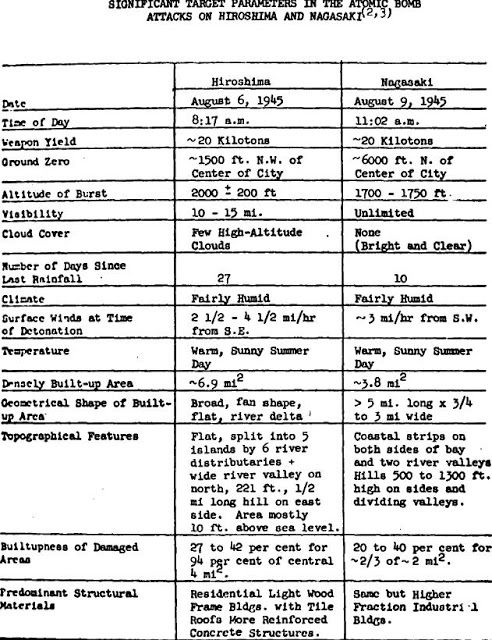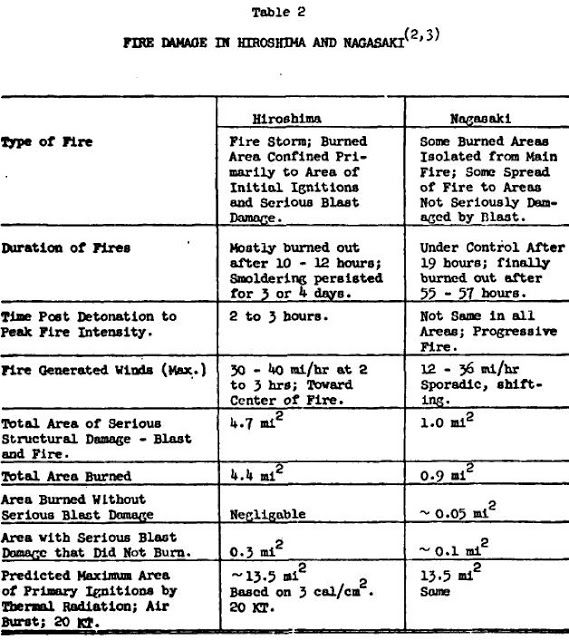This is a crosspost from Nextbigfuture
I looked at nuclear winter and city firestorms a few months ago I will summarize the case I made then in the next section. There is significant additions based on my further research and email exchanges that I had with Prof Alan Robock and Brian Toon who wrote the nuclear winter research.
The Steps needed to prove nuclear winter:
1. Prove that enough cities will have firestorms or big enough fires (the claim here is that does not happen)
2. Prove that when enough cities in a suffient area have big fire that enough smoke and soot gets into the stratosphere (trouble with this claim because of the Kuwait fires)
3. Prove that condition persists and effects climate as per models (others have questioned that but this issue is not addressed here
The nuclear winter case is predictated on getting 150 million tons (150 teragram case) of soot, smoke into the stratosphere and having it stay there. The assumption seemed to be that the cities will be targeted and the cities will burn in massive firestorms. Alan Robock indicated that they only included a fire based on the radius of ignition from the atmospheric blasts. However, in the scientific american article and in their 2007 paper the stated assumptions are:
assuming each fire would burn the same area that actually did burn in Hiroshima and assuming an amount of burnable material per person based on various studies.
The implicit assumption is that all buildings react the way the buildings in Hiroshima reacted on that day.
Therefore, the results of Hiroshima are assumed in the Nuclear Winter models.
* 27 days without rain
* with breakfast burners that overturned in the blast and set fires
* mostly wood and paper buildings
* Hiroshima had a firestorm and burned five times more than Nagasaki. Nagasaki was not the best fire resistant city. Nagasaki had the same wood and paper buildings and high population density.
Recommendations
Build only with non-combustible materials (cement and brick that is made fire resistant or specially treated wood). Make the roofs, floors and shingles non-combustible. Add fire retardants to any high volume material that could become fuel loading material. Look at city planning to ensure less fire risk for the city. Have a plan for putting out city wide fires (like controlled flood from dams which are already near cities.)
Fire and Details
If there are not multiple citywide firestorms then there is no trigger for nuclear winter even if the later modeling (which is still uncertain) would even need to be considered.
- The Material of the Houses in India and Pakistan do not appear to be Right for Firestorms (mostly burnt brick and mud)
Firestorms have always required at least 50% of buildings to be ignited. High percentage of builtupness is also necessary
Hiroshima had most fires from overturned breakfast charcoal braziers.
References that provide the basis of my case Problems of Fire in Nuclear Warfare, Jerome Hill, Rand, 1961
- Nagasaki had no firestorm
4.4 square miles Hiroshima actual burned area
0.9 square miles Nagasaki
13.5 square miles maximum theoretical .
India building census indicates that most of the buildings are made from Burnt Brick, mud which are non-combustible.
Exploratory Analysis of Fire Storms, Stanford Research Institute, 1965
The frequency of rain in India or Pakistan is important because of the effect of recent rain on burning of cities.
Quantitive — seasonal rainfall patterns for India and Pakistan
Fire Factors
“Mass fires and Fire Behaviors” which studies fires in cities and other places indicates that combustible roofing material is a major cause of fires spreading in cities. This document also discusses how to reduce fire risks and lessen spreading of fires. The usual vegetation management that is commonly mentioned for LA fires and having non-combustible roofing materials and gaps between buildings. These anti-fire measures would apply to lessoning fires ignited by nuclear bombs too.
http://www.fs.fed.us/psw/publications/documents/psw_rp019/psw_rp019_part1.pdf
http://www.fs.fed.us/psw/publications/documents/psw_rp019/psw_rp019_part2.pdf
http://www.fs.fed.us/psw/publications/documents/psw_rp019/psw_rp019_part3.pdf
Steps to Reduce Damage
Simple civil defence and building improvements would reduce damage from nuclear war and from hurricanes and earthquakes. Haiti and New Orleans show the importance of building better to greatly reduce problems.
Further improvement for buildings
Fighting Fires with Water From Behind Dams
There are also some basic counter measures against city wide fire.
More than 2,000 dams near population centers are in the United States are in need of repair, according to statistics released this month by the Association of State Dam Safety Officials. there are more dams near population centers which do not need repair. The water could be released in an emergency to more effectively fight any large area of fire.



So full-scale nuclear warfare never was nor never will be a truly existential threat?
I will be adding my article on supervolcanos and archeology.
http://nextbigfuture.com/2010/04/historical-supervolcanoes-and.html
this indicates that the climate effects also seem to be less than the nuclear winter people say. So my view is that all out nuclear war will not trigger nuclear winter (to the level specified in the research) and will not kill all people. But that still means you should avoid nuclear war and if their were millions of nuclear devices hthen that woujld be getting to existential risk. Also, there is no upper limit on nuclear fusion power. So if one were to use nanotech to sort out the deuterium on a gas giant then fusion it, that would be an existential threat.
I am also saying that steps can be taken that would mitigate nuclear weapon effects. The same kind of steps that would limit citywide fires and limit earthquake damage. How you build things matters a lot. See the difference between Haiti and Chile against earthquakes. Why do people think that how you build things is not equally as important against nuclear devices. I also feel that non-proliferation is not good as the only strategy. It like going into a boxing match with the strategy of never getting hit.
I agree that all out nuclear war will not trigger nuclear winter (to the level specified in the research) and will not kill all people. But that still means you should avoid nuclear war and if there were millions of nuclear devices then that would be getting to existential risk.….Business Colony
Hello Brian- your name sounds familiar- did you write that book explaining space flight a decade or year ago? I have it at home. Really really excellent. I want to make sure after I was short with a world famous author on another thread. I am definitely no rocket scientist.
You might be right Brian- and you might be wrong.
Having been nay sayed so many times myself, I dislike throwing stones at other peoples contributions. I have been simply dismissed as a liar and an idiot so many times I have lost count.
So with that said, please do not take my criticism the wrong way and consider it an opportunity to prepare for such criticisms.
There is a difference between an H-bomb and a first generation fission bomb. In fact, there is so big a difference in the heat pulse and radiation generated over a city that.……your comparison is not convincing to me unless you can provide more numbers. Not that I am trained to interpret such data and I would be easy to fool but you seem like the kind of person who would not blow smoke up my skirt. I may be missing alot here so if the following factors were taken into account please delete this comment.
There is no mention of the natural gas, automobiles (several million per city) and prevalence of alloys that burn quite well along with above ground gasoline storage. When ignited (aluminum) and the amount of matter that will jack up the heat such as asphalt, carpeting, plastic furniture, paint, and on and on- is not a good comparison with a 1945 Japanese city. High rise buildings and other structures that survive or collapse into perforated wreckage also act like blast furnaces efficiently consuming their contents- including people. I may be engaging in hyperbole but it seems like comparing a match to a cup of gasoline. H-bombs clouds also go really high and would this not much more efficiently transport smoke into the upper atmosphere?
While our nuclear arsenal has decreased dramatically there is the offset of improved quality control and electronics that mean many more of the submarine based missiles, land based missiles, and even whatever bombers manage to get off the ground will actually incinerate cities.
But.……events like Krakatoa are in your favor when doubting nuclear winter. Even so, after watching the movie “The Road” I do not have a good feeling about what will happen if civilization collapses. Movies do not usually impress me but that one was different. We might self-destruct so completely that there will be very few survivors and who knows what will happen to them? It is a possible existential threat in the sense that it will leave the human race vulnerable to another disaster such as a virulent disease that might put the nail in the coffin. Such things happen.
Thanks for your time reading this.